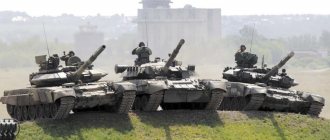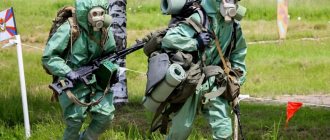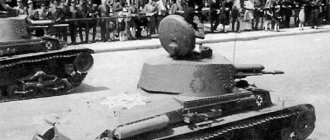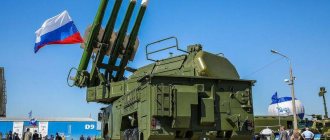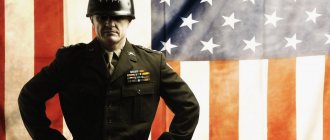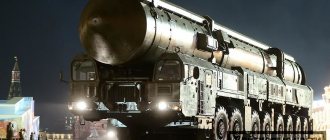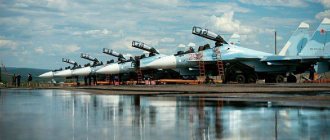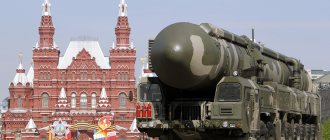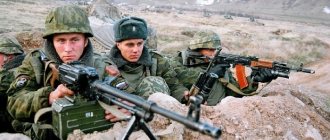The Russian Ground Forces represent the most significant part of the Russian Armed Forces. All armed conflicts that have ever occurred in the country are resolved with the help of this particular type of troops. Combat training of ground forces, even without interaction with other types of armed forces of the Russian Federation, is capable of ensuring the national security of the country. In 2022, ground troops received a host of new military equipment, according to the Army's military modernization program. October 1 is considered Ground Armed Forces Day.
How the Ground Forces of the Russian Federation appeared
The entire military history of the Russian army is closely connected with the Ground Forces. For centuries, it was this branch of the military that not only played the main role in all military conflicts, but was also the only type of troops. Only with the advent of the navy did the Ground Forces lose their position a little, although even now they are the largest in any army in the world.
Although military squads existed on the territory of Rus' for quite a long time, it was only in 1550 that Tsar Ivan the Terrible laid the foundation for the formation of professional military forces. October 1, 1550 became the day of the Ground Forces, since it was on this day that the first army appeared, which was radically different from the people's militia and feudal noble squads. Currently, the Day of the Russian Ground Forces is celebrated on October 1.
The next significant date in the history of Russian military forces was November 1699, when the decrees of Peter I first mentioned recruitment based on territorial grounds. It was the developments of Peter I in this area that led to the emergence in 1763 of the first unified structure of infantry regiments, which consisted of the following military units:
- 2 grenadier companies;
- 10 musketeer companies;
- Artillery team.
All 12 companies were consolidated into two battalions, which made it possible to better coordinate their actions in battle.
In the 18th century, military divisions and corps appeared. Each division was a military formation, which included 3 types of ground forces:
- Infantry;
- Artillery;
- Cavalry.
This division allowed the troops to more clearly carry out their assigned tasks.
The most fruitful period in the formation of the Russian Ground Forces was the formation of the Soviet Army. It was then that motorized troops appeared, although the process of motorization dragged on for many years. After the start of the Great Patriotic War, a powerful impetus was given to the development of the ground forces. During the war years, the weapons of the Ground Forces were improved. The uniform was also modernized during the Second World War. Shoulder straps, which after the revolution were the object of hatred among revolutionaries, were reintroduced as a sign of belonging to the ruling class.
After the Second World War, the USSR continued the global modernization and improvement of the Soviet army. The following groups of troops were modernized or newly created:
- Tank;
- Anti-aircraft missiles;
- Artillery;
- Helicopters and so on.
Accelerated modernization, in which billions were invested, took place within the framework of the Cold War, when the USSR competed with the United States in the arms race. Numerous military training centers were opened throughout the country to train junior and senior commanders. Huge amounts of money were also invested in defense. The composition of the ground forces was constantly increasing due to the addition of new types of troops.
Navy
The Navy (VMF) is a branch of the Armed Forces of the Russian Federation (RF Armed Forces). It is intended for the armed protection of Russian interests and for conducting combat operations in the sea and ocean theaters of war.
The Navy is capable of delivering nuclear strikes on enemy ground targets, destroying enemy fleet groups at sea and bases, disrupting the enemy’s ocean and sea communications and protecting its maritime transportation, assisting the Ground Forces in operations in continental theaters of war, landing amphibious assault forces, and participating in repelling landing forces. enemy and perform other tasks.
The Navy includes:
Surface forces are the main ones for ensuring the exit and deployment of submarines to combat areas and returning to bases, transporting and covering landing forces. They are assigned the main role in laying minefields, combating mine danger and protecting their communications.
Surface forces
The Submarine Force is a branch of the Navy's forces that includes nuclear-powered strategic missile submarines, nuclear-powered attack submarines, and diesel-electric (non-nuclear) submarines.
The main tasks of the submarine force are:
- defeating important enemy ground targets;
- search and destruction of enemy submarines, aircraft carriers and other surface ships, its landing forces, convoys, single transports (ships) at sea;
- reconnaissance, ensuring the guidance of their strike forces and issuing target designations to them;
- destruction of offshore oil and gas complexes, landing of special-purpose reconnaissance groups (detachments) on the enemy coast;
- laying mines and others.
Submarine forces
Organizationally, submarine forces consist of individual formations that are subordinate to the commanders of submarine formations and the commanders of formations of heterogeneous fleet forces.
Naval aviation is a branch of the Navy forces intended for:
- search and destruction of combat forces of the enemy fleet, landing detachments, convoys and single ships (vessels) at sea and at bases;
- covering groupings of ships and naval facilities from enemy air strikes;
- destruction of airplanes, helicopters and cruise missiles;
- conducting aerial reconnaissance;
- targeting enemy naval forces with their strike forces and issuing target designations to them.
Also involved in mine laying, mine countermeasures, electronic warfare (EW), airlift and landing, search and rescue operations at sea.
Naval aviation
The basis of naval aviation consists of aircraft (helicopters) for various purposes. Performs assigned tasks independently and in cooperation with other branches of the fleet, as well as with formations (units) of other branches of the Armed Forces.
Coastal Forces (BC) - a branch of the Navy, designed to cover the forces of fleets, troops, populations and objects on the sea coast from the influence of enemy surface ships; defense of naval bases and other important fleet facilities from land, including from sea and airborne assaults; landings and actions in sea, air and sea landings; assistance to ground forces in anti-landing defense of amphibious assault areas of the sea coast; destruction of surface ships, boats and landing vehicles within the reach of weapons.
Coastal troops include 2 types of troops: coastal missile and artillery troops and marine infantry.
Each branch of the military solves certain target tasks independently and in cooperation with other branches of the military forces and naval forces, as well as with formations and units of other branches of the Armed Forces and branches of the military.
Coastal troops
The main organizational units of the military units are brigades and battalions (divisions).
BVs are equipped primarily with weapons and equipment of the combined arms type. They are armed with coastal missile systems (CBM) of anti-ship guided missiles, stationary and mobile artillery installations designed to destroy sea and ground targets, special (marine) reconnaissance equipment, etc.
The modern structure of the Russian Ground Forces
Modern Russian Ground Forces are a formidable force. They consist of the following types of troops:
- The basis of the ground forces are the Motorized Rifle Troops. This type of troops consists not only of motorized infantry, they have powerful weapons that are capable of hitting both ground and air targets. The motorized rifle troops include various anti-tank systems, artillery, anti-aircraft missile systems and other types of troops, including air defense. Ground forces training centers train many specialists specifically for the Motorized Rifle Forces;
- Tank troops are in second place in importance after Motorized Rifle Troops. Their main task is to deliver powerful and deep penetrating blows to the enemy. Most often, Tank troops work in close conjunction with Motorized Rifle Troops;
- Rocket and artillery troops strike enemy firing points and serve to destroy large concentrations of enemy manpower or equipment. They also work closely with the Motorized Rifle and Tank Troops;
- The air defense of the Ground Forces is engaged in repelling enemy air raids. During military operations, the main task of the air defense of the Ground Forces is to protect troop groups, as well as the rear, from air strikes. Modern air defense systems of the Ground Forces are capable of destroying threats at a considerable distance, preventing the enemy from approaching strategically important points and objects. They are capable of providing comprehensive air defense;
- Special forces are a system consisting of various military formations, organizations and institutions that are responsible for carrying out the combat activities of all types of Ground Forces.
The Combat Manual of the Ground Forces (BUSV) is a reference book for every soldier of the Ground Forces. It describes in great detail the preparation and conduct of combined arms combat. The combat training of the Ground Forces is regulated by a collection of standards for combat training. The first charter dates back to 1607. Already at that time he described in sufficient detail the principles of combat.
The ranks of the Ground Forces are no different from the ranks of other types of Russian troops. The only branch of the military where there are different ranks (for example, captain 1st rank) is the Navy.
During Soviet times, the training of officers of the Ground Forces was mainly carried out by the Military Institute of the Ground Forces. After the collapse of the USSR, the military training and scientific center of the Ground Forces, which is located in Moscow, has been training the Russian military in this area. Its educational program is based on the centuries-old traditions of the Russian army, closely intertwined with the latest technologies.
Subordination and command
Conversions in the army are carried out according to the strict regulations of the regulations. Military formations use vertical and horizontal hierarchy. The first is built depending on the ranks, and the second - on the positions held. The lowest military rank in any branch of the armed forces of the Russian Federation is private. Soldiers who have already served for a certain time receive the rank of corporal. Further, the importance of ranks is similar to that used in the Ministry of Internal Affairs.
The commander of a combat vehicle or squad receives the rank of sergeant. This is the junior command staff. It is assigned to cadets who have completed training or to privates who have shown excellent results in combat training.
The junior command staff is divided into junior sergeant, sergeant and senior sergeant. The following ranks apply to junior officers. They are assigned to graduates of military educational institutions or universities who have graduated from the military department. These ranks include lieutenants and captains. They command a company or platoon.
Then come the senior ranks: major, lieutenant colonel and colonel. They can command battalions or regiments. Senior officer ranks are awarded only after training at a military school. The colonel controls the brigade. The top officer corps closes the list of rank hierarchy. It starts with the rank of major general, then lieutenant general and colonel general. The army general controls everything. The highest military rank is Marshal of the Russian Federation.
Rank insignia is indicated on shoulder straps with stars or stripes (non-commissioned officers). Depending on the size of the stars, affiliation with the officer corps is determined. So, small two stars on the shoulder strap correspond to a lieutenant, and large ones to a lieutenant colonel.
The army general wears shoulder straps with an embroidered 40 mm star framed by a wreath, the marshal wears a large star located under the coat of arms of Russia with radiating silver rays forming a pentagon. The infantry version of the uniform differs from the ceremonial version in its camouflage design. Private soldiers have no insignia.
Military-industrial complex of the Ground Forces
Modern Russia inherited the military-industrial complex from the USSR. During the Cold War, it reached significant heights and even in that state was able to provide modern ground forces with everything they needed. But time does not stand still, and technology is developing rapidly. The Russian military-industrial complex, which practically did not develop in the 90s, began to rapidly gain momentum starting from the second half of the 200s. This has become especially noticeable in the last 10 years. Now Russia, which was previously the largest supplier of Soviet weapons, has begun to confidently lead in the field of sales of modern types of weapons. Most of the Russian weapons that are exported are intended for ground forces.
Currently, the Russian military-industrial complex fully provides the Ground Forces with everything they need:
- First of all, these are small arms of various types and ammunition for them;
- Armored vehicles of various types, including tanks, armored personnel carriers, infantry fighting vehicles and other similar vehicles;
- Artillery weapons of various types;
- Rocketry and much more.
Dozens of Russian design bureaus and various specialized industries are engaged in the development, production and testing of military equipment, weapons and uniforms. Although most of the ground forces' weapons are still models that were produced or developed in the USSR, military reforms that have been carried out in recent years are aimed at modernizing the Ground Forces in accordance with world standards.
In order to understand the full potential of the Ground Forces, it is necessary to take a closer look at each type of force that belongs to the Ground Forces.
Armament
Soldiers have Kalashnikov assault rifles
. It is clear that all special forces soldiers have personal weapons. Firearms, as a rule, are Kalashnikov assault rifles for soldiers and Makarov pistols for officers. But each unit also has its own specific weapons, that is, special technical means to perform its immediate tasks.
For signalmen, these are radio stations and entire communication systems installed on armored personnel carriers or trucks, command and staff vehicles. Engineers have various engineering equipment, railway workers have their own trains and locomotives.
The material and technical base of any type of troops is complete, diverse and even, if possible, automated. For example, in the chemical forces, radiochemical reconnaissance vehicles are equipped with special devices for automatically driving in marker pegs. Everything is done so as not to distract military personnel from performing combat missions.
Russian motorized rifle troops
This branch of the military, created in 1963, is the basis of the Ground Forces of the Russian Federation. The main advantages of motorized rifle troops are their mobility and high firepower. Armed with both Soviet-made weapons and the latest types, motorized rifle troops are capable of effectively destroying any type of target.
Having not only motorized rifle units, but also tank, anti-aircraft, artillery and other units, motorized rifle troops are capable of performing a wide range of combat missions, and the presence of special forces units in their composition makes deep raids behind enemy lines a reality.
Motorized rifle units of the modern Russian army are fully equipped with combat vehicles, including the latest models, developed taking into account modern world standards. According to the latest information, new military equipment is currently being developed for motorized rifle troops, which should soon enter service in the coming years.
Aerospace Forces
The Aerospace Forces of the Armed Forces of the Russian Federation (VKS RF Armed Forces) is a branch of the Armed Forces of the Russian Federation that began fulfilling its tasks on August 1, 2015 in accordance with the decree of the President of the Russian Federation V.V. Putin.
The Aerospace Forces of the Russian Armed Forces are a new branch of the Armed Forces, formed as a result of the merger of the Air Force (Air Force) and the Aerospace Defense Forces (VVKO) of the Russian Federation.
The general leadership of the aerospace defense of Russia is carried out by the General Staff of the Armed Forces of the Russian Federation, and the direct leadership is carried out by the Main Command of the Aerospace Forces of the Russian Federation.
The Aerospace Forces of the Russian Armed Forces include:
The Air Force of the Russian Federation (Russian Air Force) is a branch of the forces within the Aerospace Forces of the Armed Forces of the Russian Federation (Russian Armed Forces).
Air Force
The Russian Air Force is intended for:
- repelling aggression in the air sphere and protecting command posts of the highest echelons of state and military administration, administrative and political centers, industrial and economic regions, the most important economic and infrastructure facilities of the country and troop groups from air strikes;
- defeating enemy targets and troops using both conventional and nuclear weapons;
- aviation support for combat operations of troops of other types and branches of troops.
The Space Forces solve a wide range of tasks, the main of which are: • monitoring space objects and identifying threats to Russia in space and from space, and, if necessary, countering such threats; • launching spacecraft into orbit, controlling military and dual-purpose (military and civil) satellite systems in flight and using some of them in the interests of providing the troops (forces) of the Russian Federation with the necessary information; • maintaining the established composition and readiness for use of military and dual-use satellite systems, means of launching and controlling them, and a number of other tasks.
Space Force
Let's move on to consider the final type of the Armed Forces of the Russian Federation.
Tank troops of the Russian Federation
During the Soviet era, the main strike force of the Ground Forces was the Tank Forces. The Russian army received a huge fleet of combat vehicles from the USSR, numbering about 23,000 battle tanks as of 2005. Most of these tanks were obsolete models that were gradually withdrawn from service. In 2009, only 2,000 combat vehicles remained in service.
The most promising Russian tank is the tank on the Armata platform. By 2022, it is planned to purchase a significant number of such vehicles, thus updating the tank fleet. Now the most popular tank of the Russian Tank Forces is the T-72 and its various modifications. There are a significant number of tanks of the T-80 and T-90 models. In addition, according to unconfirmed reports, the Tank Forces have about 8,000 more tanks of older models that are in working order.
The big advantage of modern Tank forces are the following parameters:
- High mobility and maneuverability;
- Firepower;
- Resistance to weapons of mass destruction.
In addition, modern tanks are capable of crossing significant water obstacles and conducting combat operations with equal effectiveness both during the day and at night.
Rocket and artillery troops
This branch of the military is the most significant force in the modern world. Having formations of tactical missiles, missile and artillery troops are capable of using weapons of mass destruction.
Due to the tense situation associated with the hard-line policies of the United States, Russia is investing heavily in the development of powerful intercontinental missiles capable of carrying out targeted strikes on almost any part of the world. This measure is forced, and in no way speaks of Russian military aggression.
Although the majority of the Rocket Forces' weapons consist of Soviet-era missile systems, there are a number of new developments that have been successfully adopted. For example, the Tornado MLRS or the Iskander missile system.
Air Defense Forces of the Ground Forces
As for the air defense troops, one should not confuse the air defense, whose task is to ensure the air security of Russia, and the air defense troops of the Ground Forces, which are responsible specifically for the troops they cover and the territory of their deployment.
Having in its arsenal a wide range of different anti-aircraft systems, the air defense of the Ground Forces is able to combat various air threats in a wide speed and altitude range.
The main disadvantage of modern air defense of the Ground Forces is the fact that about 50% of the weapons are very outdated. The modernization of this type of troops is carried out at too slow a pace.
Emblems
Emblems of all special ground forces
Each type of army has its own emblem, reflecting specific features. Over the decades, as a result of political changes in the country, they, of course, changed, but the main elements remained unchanged.
The engineers' chevron depicts an excavator bucket.
For chemists, this is a sign of biological and chemical danger, recognizable all over the world - three rings connected in the form of a trefoil and pierced in a circle by a fourth ring.
Signalmen have crossed lightning bolts and wings on their buttonholes and chevrons.
The electronic warfare troops have a dark shield with a drawing of the Earth on it, against the background of which is a fist squeezing lightning. On the chevron of the electronic warfare troops there is a double-headed eagle and St. George, the patron saint of military personnel.
The railroad chevron features a bridge element, a railroad wheel, crossed sledgehammers, and wings.
Motorists wear an emblem consisting of twin wheels, a steering wheel and fenders.
On the uniform of the pipeline troops there is an emblem containing a pipe element with a valve axle box and valve.
Special troops
Special troops that are part of the Ground Forces are capable of solving various tasks that arise during combat operations. The Ground Forces have a significant number of special forces:
- Chemical Defense Troops;
- Railway Troops;
- Automotive Troops;
- Signal Corps;
- Road Troops;
- Pipeline Troops;
- Corps of Engineers.
All these types of troops are designed to solve logistics problems that inevitably arise in military conflicts of any scale. The supply of ammunition, food, provision of communications and communications - this is not a complete list of tasks that the special forces that are part of the Ground Forces of the Russian Federation solve.
Modern Russian Ground Forces have begun to modernize at an accelerated pace in recent years. The prestige of military professions is rising, as a result of which more and more young people want to connect their lives with the Russian army.
History of the creation of divisions
Each branch of the military has its own history of creation:
The engineering troops consist of support units for troops on the march, in defense and in the offensive. These are engineering sapper troops, road engineering, pontoon and other units. The exact date of creation was lost back in the 9th century AD. That is, this type of army arose along with fortifications and city walls. After all, they had to be built, and if the city was attacked, they had to be destroyed. This is the work that military engineers did.
The most striking event associated with the engineering troops was the capture of Kazan. In the 16th century it was a large, well-fortified city, which was impossible to capture from a swoop. Moreover, the Russian troops that approached the walls of the city presented an excellent target for the defenders. There was no place to store supplies, treat the wounded or simply rest, there was also no way. In this regard, a fortress was built on the Sviyaga River, 25 km from Kazan, combining a hospital, warehouses and a resting place for soldiers. And in order to build this fortress quickly and unexpectedly for the people of Kazan, the prepared logs and parts of the walls were lowered along the Volga from the city of Uglich. Thus, the fortress was built in a record 28 days. Around the same period, various engineering structures were developed that saved many soldiers' lives and positively influenced the course of various military companies. For example, the “walk-city” was invented - log shields transported on carts and serving as mobile shelter for cavalry and artillerymen.
The troops of radiation, chemical and bacteriological protection (RCBZ) began their journey with the First World War, during which toxic substances in the form of gas began to be used. And where there are chemical weapons, chemical protection is also needed. After the adoption of atomic and thermonuclear weapons, it was necessary to ensure the protection of personnel and equipment from the damaging factors of nuclear explosions. RCBZ troops are engaged in reconnaissance of radioactive and chemical contamination, carry out work on deactivation and decontamination of affected areas, military equipment and personnel. They also provide personnel with chemical and radioactive protection equipment, which includes not only a gas mask and a protective equipment kit, but also special decontaminating substances.
Signal Corps . It is difficult to overestimate the importance of this type of troops. After all, communications is the nervous system of all Armed Forces. They provide command and control of troops at any level: from squads to units and formations. Military signalmen are on duty even in peacetime. After all, during exercises, when other troops are simulating combat operations, it is impossible to imitate data exchange and communications. The use of telegraph communication began during the Russian-Turkish War in 1877. This event marked the beginning of the use of wired communications. Radio communications began to develop with the Russo-Japanese War in 1905, when military radio stations were first used. At the moment, signal troops are represented by dozens of special signal brigades and hundreds of individual companies and battalions.
Electronic warfare troops perform the task of protecting the radio air from penetration by a potential enemy, and electronic warfare troops also protect their command and control systems for troops and units. The history of the use of electronic warfare began with the Russian-Japanese War, when, by order of the commander of the Pacific Fleet, it was possible to suppress radio traffic between enemy ships by interference, which led to the defeat of the enemy. Work to suppress radio traffic between the headquarters and units of a potential enemy is ongoing. Modern electronic warfare troops cover radio broadcasts from all possible directions.
Military reconnaissance units initially carried out various tasks in order to provide command with information about the enemy, the state of the terrain and the weather in order to make adequate decisions for the operation (battle) and prevent the surprise of enemy actions.
The youngest are the information operations troops . The need for their creation is explained by the development of the Internet and network structures of military command and control. The task of these troops is to protect automatic control networks from enemy attacks and influences.
The rear troops are a multi-level structure that emerged on the basis of the development of means of transport and construction equipment. They include railway troops, which ensure the transportation of personnel and military equipment by rail, road troops, without which the transfer of food, weapons and personnel throughout Russia is impossible, road construction and pontoon formations, as well as pipeline troops.
